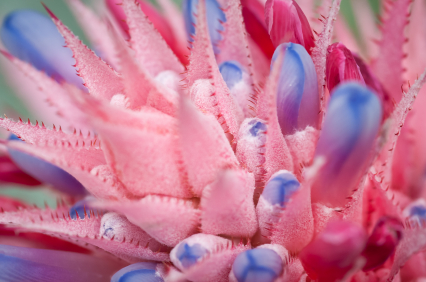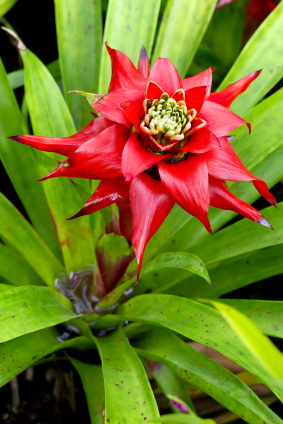7 Easy to Grow Bromeliads
Author: Celeste BoothNo Comments
Bromeliads are tropical plants that are typically easy to grow. There are a few that are fussier than others. Some bromeliads require high amounts of humidity or light to thrive, others need special temperatures. Many bromeliads just need an occasional watering and that is it.
The bromeliads discussed in this post are perfect for the those that don’t have a lot of time to take care of plants. If you are just learning about bromeliads or want a plant that doesn’t demand much attention, these bromeliads are for you.
1. Aechmea fasciata

– Aechmea fasciata
The Aechmea fasciata, also called the silver urn plant, is an all star foolproof plant. The plant will thrive as long as its very basic needs are met. You should water the potting medium once a week and keep water in the cups formed at the axils of the leaves. The plant prefers a well draining potting medium and a location with plenty of bright indirect light.
The plant has beautiful foliage with broad, deep green leaves and silvery banding. It produces light pink inflorescence with small purple flowers. This plant will reward the grower with a long lasting bloom followed by the production of pups that can be removed and repotted.
2. Aechmea recurvata
This plant has slender yellow green foliage that stands upright. It produces hot pink inflorescence with bright blue flowers in the center of the plant. Aechmea recurvatais a small plant that grows only 8 inches tall. It can be planted in a small container or mounted. This plant prefers bright indirect light, but withstands a small amount of direct sunlight during the day. A weekly watering should provide enough to keep the plant healthy.
3. Dyckia fragrans
Dyckias are a genus of bromeliad that is easy to care for in general. They prefer full sunlight, but will tolerate partial shade. They are adapted to arid climates so they do not need to be watered very often. Dyckias can also tolerate colder temperatures better than most other bromeliads.
Dyckia fragrans is a beautiful chocolate foliaged plant. It has leathery leaves with distinct pinkish spikes all the way around the leaf margins. When it flowers it produces a flower spike with bright yellow flowers and a pleasant fragrance. One advantage to Dyckias is that unlike other bromeliad genera they do not die after flowering and may even produce more flowers. Dyckia fragrans is a terrestrial species that should be potted in a mix rich with organic material. Dyckias often grow to the size of their pot. Keep that in mind when choosing a container. Dyckia fragrans is a unique plant that pups generously and is very undemanding. It would be a great addition to any beginners collection.
4. Tilandsia ionantha
Tilandsia ionantha is a small air plant. It is epiphytic, so it should be mounted on a substrate, such as a piece of drift wood or bark. They can even be hung as ornaments in glass orbs. The plant grows only a few inches and it pups easily, creating a full looking mass. It has lighter green leaves with silvery scales. The leaves towards the center of the plant blush pink or red. It also produces a brilliant purple flower spike.
The plant is adapted to bright arid climates, so it likes plenty of sunshine. A bright window is ideal, but make sure it doesn’t get too hot. The plant takes in water and nutrients through its leaves so it must be misted with a spray bottle. You can mist daily through the spring and summer growing season. However, the plant is very forgiving so don’t panic if you miss a day or two. The Backyard Gardener suggests adding 1/4 strength fertilizer to the mist once a month during the growing season. The ease of care and exotic beauty of these plants make them fun to have in your home.
5. Guzmania lingulata

– Guzmania lingulata
Also known as the scarlet star bromeliad, Guzmania lingulata, is an easy species to find at nurseries and garden stores. It has dark green, leathery leaves. The center forms a red inflorescence when ready to bloom. The color will last up to 5 months while the plant blooms. The blossoms themselves are small and white and are typically hidden by the bright red inflorescence. A healthy plant will easily produce pups after it has finished flowering.
The Guzmania lingulata requires bright indirect light and should be protected from direct light. This plant is slightly more finicky about humidity than others. If your plant seems to be suffering you may want to put a humidifier nearby or move it to a kitchen or bathroom. Place water in the central cup of the bromeliad and rinse and replace it once a week. It is best to use distilled or rainwater because tap water will leave build up on the leaves.
6. Vriesea splendens
Vriesea splendens is on the slightly more difficult side of easy bromeliads. Its major requirement is humidity. It is also a bit more susceptible to root rot than other species. That said, the plant still requires relatively little care. The soil should be allowed to dry between waterings, then soaked thoroughly. This should happen about once a week or less often depending on your container. It is better to err on the side of too dry than too wet. If the space has low relative humidity, place a try filled with pebbles and a few inches of water next to or under the plant. Make sure the container is not sitting directly in the water. The tray will add moisture to the air and allow the plant to thrive.
The foliage is broad and leathery. It is a dark green color with lighter green or white horizontal banding. Bright, indirect light will bring out the attractive banding on its foliage. Vriesea splendens produces a broad, flat inflorescence that rises above the foliage through the center of the plant. The inflorescence gives the plant its common name, flaming sword. The flaming sword is brilliant red with yellow or orange accents. There are many cultivars of this species with varying foliage and inflorescence colors.
7. Bilbergia nutans
This plant is hardy and will tolerate neglect. Bilbergia nutans is best known for its unique and colorful inflorescence. It has bright pink bracts and a red flower stalk that hangs down in a pendant from the plant. It is often called the queens tears because of the nectar that drips from the flowers.
Bilberiga nutans should be planted in a well draining potting mix. The plant can grow up to 12 inches tall and 30 inches wide. Be sure to give it enough space to grow. The soil should dry between waterings, but the central rosette should not be allowed to dry out. The plant likes bright indirect sunlight, but it will also tolerate partial shade. Guide to Houseplants warns that if it is not flowering, it may not be getting enough sunlight. However, keep in mind it usually takes this plant 2-3 years to reach maturity and begin flowering.
Where to Buy Bromeliads
Choose one of these seven bromeliads for an easy to care for indoor plant. If you are just starting your bromeliad collection, you will not fail with these species or their cultivars. Most can be found at nurseries or tropical specialty stores. For more information about where to buy bromeliads see the Essential Bromeliad Buyers Guide.
Sources
“Billbergia nutans aka Queen’s Tears or Friendship Plant” Guide to Houseplants. <http://www.guide-to-houseplants.com/billbergia-nutans.html>
“Bilbergia nutans” Buzzle. <http://www.buzzle.com/articles/billbergia-nutans.html>
“Dyckia” Bromeliad Society/Houston. <http://bromeliadsocietyhouston.org/genera-intro/dyckia/>
“Dyckia fragrans” The Nature Collection. <http://www.thenaturecollection.com/pgdyckiafragrans.htm>
“James Bond (Vriesea splendons)” Plants Are The Strangest People. <http://plantsarethestrangestpeople.blogspot.com/2008/10/james-bond-vriesea-splendens.html>
“Scarlet Star.” Guide to Houseplants. <http://www.guide-to-houseplants.com/bromeliad-scarlet-star.html>
“Tillandsia ionantha (air plant)” Backyard Gardener. <http://www.backyardgardener.com/plantname/pda_4528.html>
“Tillandsia ionantha (blushing bride)” Kew Gardens. <http://www.kew.org/plants-fungi/Tillandsia-ionantha.htm>

Resource Download
Hechtia Care Cheat Sheet
Learn how to care for your Hechtia bromeliad with this quick and easy informational guide.
Learn More
Ask an Expert
Questions about bromeliads?
Our experts love a challenge!
Photo of the Week
Submit your photo to be featured on the blog!
More Photo of the Week Winners
Submit Photo







